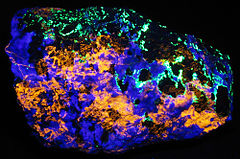- Clinohedrite
-
Clinodehrite 
Clinohedrite coating hardystonite, franklinite with willemite reaction rims. Franklin, New Jersey. Orange fluorescence under UV.General Category Silicate mineral Chemical formula CaZn(SiO)4·H2O Strunz classification 9.AE.30 Dana classification 52.2.1.2 Crystal symmetry Monoclinic point group m Unit cell a = 5.09 Å, b = 15.82 Å, c = 5.38 Å; β = 103.39°; Z = 4 Identification Color Colorless to brown surface coating, clear to pale pink to amethystine crystals Crystal habit Thin to thick or platey surface and fracture coatings, in vugs or cavities, rarely as crusts of crystals - prismatic to tabular, may be wedge-shaped Cleavage Perfect on {010} Mohs scale hardness 5.5 Luster Brilliant, glassy; pearly on {010} Streak white Specific gravity 3.28 - 3.33 Optical properties Biaxial (-) Refractive index nα = 1.662 nβ = 1.667 nγ = 1.669 Ultraviolet fluorescence UV=orange Other characteristics Strongly pyroelectric References [1][2][3] Clinohedrite is a rare silicate mineral. Its chemical composition is a hydrous calcium-zinc silicate; CaZn(SiO)4·H2O. It crystallizes in the monoclinic system and typically occurs as veinlets and fracture coatings. It is commonly colorless, white to pale amethyst in color. It has perfect cleavage and the crystalline habit has a brilliant luster. It has a Mohs hardness of 5.5 and a specific gravity of 3.28 - 3.33.[1][2]
Under short wave ultraviolet light it fluoresces a rich orange color. It is frequently associated with minerals such as hardystonite (fluoresces violet blue), esperite (fluoresces bright yellow), calcite (fluoresces orange-red), franklinite (non-fluorescent) and willemite (fluoresces green).[4]
Clinohedrite was found primarily at the Franklin zinc mines in New Jersey, the type locality, but has also been reported from the Christmas mine, Gila County, Arizona, [1] and the Western Quinling gold belt, Gansu Province, China.[2]
It was first described in 1898 and was named for its crystal morphology from the Greek klino for incline, and hedra for face.[1]
References
- ^ a b c d http://www.handbookofmineralogy.org/pdfs/clinohedrite.pdf Handbook of Mineralogy
- ^ a b c http://www.mindat.org/min-1075.html Mindat
- ^ Webmineral data
- ^ http://www.galleries.com/minerals/silicate/clinohed/clinohed.htm Mineral Galleries

This article about a specific silicate mineral is a stub. You can help Wikipedia by expanding it.
